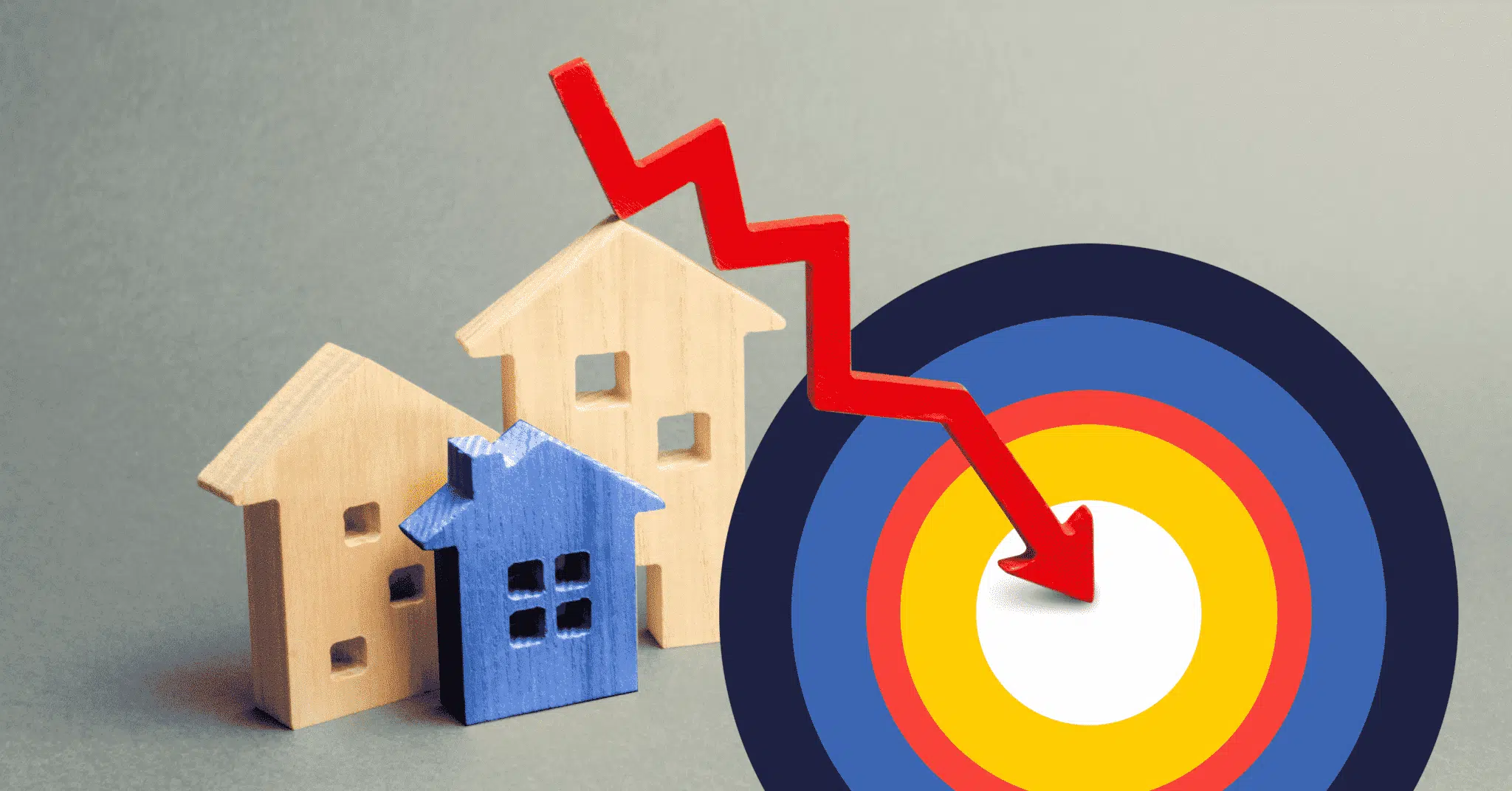Declining Home Prices Pose Risk to Canada's Financial System

Table of contents
Canada’s national banking regulator, the Office of the Superintendent of Financial Institutions (OSFI), has outlined the major risks facing the country’s financial system and what it plans to do about them in its second Annual Risk Outlook (ARO), released on April 18. According to the regulator, the most significant threats are a potential downturn in Canada’s housing market and rapidly increasing interest rates.
Key Highlights
- OSFI outlined various risks to the Canadian housing market in its annual report.
- The surge in interest rates continues to create default risk for borrowers, lenders and insurers as LTVs increase.
- Insurers disclose they increasingly carry a higher proportion of over-amortized and over-collateralized loans in access of 95% LTV.
Variable Rate Risk
OSFI has warned about the challenge of variable borrowers hitting their trigger rates. And the ensuing risk this poses for the country’s housing market. When interest rates rise, a borrower’s monthly payment for a variable-rate mortgage decreases, and the amount applied toward the principal reduces, leaving only the interest to be paid.
To ensure that federally regulated financial institutions (FRFI) are ready for changing market conditions, OSFI is intensifying its monitoring of market liquidity. While Peter Routledge, the Superintendent at OSFI, acknowledges that the housing market might weaken through 2023, he emphasizes that OSFI is prepared but not predicting such a scenario.
Furthermore, the regulator warns that transitioning to higher interest rates might be challenging. Nevertheless, OSFI is committed to maintaining a secure financial system in Canada, working to reduce potential risks and sustain the stability of the country’s financial sector.
Loan-to-Value Risks
Canadian mortgage insurers face increasingly high payouts as borrowers owe more than their properties are worth. Home prices have declined over the past year while homeowners’ equity continues to erode. As such, more borrowers now owe more than the value of their property, raising the risk of insurers’ payouts should they default on their loans.
Higher mortgage debt to property values, known as loan-to-value (LTV) ratios, escalate lenders’ and insurers’ risk if borrowers should default. Although mortgage defaults have remained historically low, insurers will have increased payouts if borrowers cannot pay higher mortgage payments.
Insurers’ disclosures look at the mortgage market’s fragility following the Bank of Canada’s rapid increase in key interest rates. In less than a year, rates increased from 0.25% to 4.50%, and the surge in borrowing costs slowed the housing market by 15.5% over that same period. These depreciating home values are forcing more borrowers from a rock to a hard place.
The loan-to-value (LTV) ratio determines lending risk. The federal bank regulator considers loans riskier if the balance homeowners owe is greater than 75% of their home’s valuation – making the LTV ratio above 75%. Mortgage insurers state a growing number of mortgagors have exceeded this threshold. Some borrowers have LTV ratios greater than 100 percent, meaning that they carry mortgage balances greater than the value of their property.
Default Insurer Risk
Mortgage insurers continue to cover banks’ losses and promise assistance to homeowners. However, increasing numbers of households need help to remain afloat in a tenuous mortgage market. Lenders calculate LTV ratios by dividing the current mortgage balance by the estimated current property value, adjusting for recent declines in home prices in different communities.
Canada Guaranty, one of the private mortgage default insurers in Canada, has disclosed that more than $4 billion of insured mortgages had an estimated LTV ratio in excess of 100% at the end of 2021, which made up 5% of its insured mortgage. These figures are a significant increase from the last quarter of 2020, where $532 million, or 0.74%, of its outstanding insured mortgages, were affected.
If a borrower makes a downpayment of less than 20% of the purchase price of a property, mortgage insurance becomes necessary. The lender is protected against losses if the borrower defaults on mortgage payments. According to Sagen, the other private mortgage default insurer, and crown corporation default insurer Canada Mortgage and Housing Corporation (CMHC), the proportion of loans with the highest LTVs had doubled in 2022.
Sagen did not provide details on LTV ratios over 100% but showed their highest monitored ratio category above 95%. Sagen had $14 billion, or 10% of its outstanding insured mortgages, with an LTV ratio in excess of 95% at the end of 2021. These are significantly higher than $7 billion, or 5% of its insured mortgages at the end of 2020.
CMHC recorded similar growth in LTV ratios for homeowners with insured mortgages. In the third quarter of 2022, 2.8% of its insured loans had an updated LTV above 95%, reflecting an outstanding insured mortgage balance of $5 billion. Compared with the same period a year earlier in 2021, CMHC’s highest monitored LTV in excess of 95% reached 1.2%, resulting in an insured mortgage balance of $2.3 billion.
CMHC continuously monitors their business profile and adjusts underwriting policies as required. The Bank of Canada acknowledged the impact of higher interest rates on borrowers with variable-rate mortgages. Ultimately, Canada’s most popular variable-rate products have fixed payments, increasing the likelihood of borrowers defaulting as their mortgages get triggered – hitting their trigger rates and trigger points.
Stress Test and Trigger Rate Risks
Interestingly, during the pandemic, when property values were surging due to super low mortgage rates, was the last time CMHC proactively tried to reduce the risk on Canadian mortgages. At the time, the CEO and President of CMHC, Evan Siddall, tried toughening the mortgage stress test for default-insured borrowers. This tightening policy backfired. Siddall left the organization as a part of the policy flop, and the updated criteria had been reversed. In hindsight, this policy update could have avoided a lot of grief for many first-time home buyers who ended up qualifying on the ultralow variable rate during the pandemic while stretching their finances to the max.
With the rapid increase in mortgage rates, many borrowers are discovering that their monthly payments fail to cover the entire interest portion of their loans. Consequently, the unpaid interest is added to the original principal, increasing the overall loan amount, thus resulting in higher LTVs. It’s important to note that these sudden changes add stress and confusion for borrowers, but managing your loan payments better proactively is crucial. It is essential to pay closer attention to your mortgage decision-making process and monitor your mortgage’s LTV ratio to avoid any unpleasant surprises in the future.
Trigger rates are reached when the borrower’s mortgage payments only cover their interest component. When this occurs, it’s in the mortgagor’s best interest to proactively reach out to their lender and increase their payment to stay ahead of the second issue – hitting their trigger point. The trigger point is reached when a mortgage balance owing is more than the originally advanced mortgage when the borrower first took out their mortgage with their current lender. Lenders are not obligated to contact you until your LTV hits 100% – meaning your mortgage balance owing is equal to your property’s current valuation.
Frequently Asked Questions (FAQ)
What is a trigger rate?
Trigger rate is when your variable rate mortgage with a fixed payment no longer covers any principal repayment. The full payment is going to interest as your payment is fixed. There are no increases in your payment to compensate as the prime rate increases.
How do I calculate my trigger rate?
Payment amount x number of payments per year/balance owing x 100 = trigger rate in %. So if your payment is $1800 biweekly and you owe $651,000, your trigger rate will be 7.19%. This is calculated as $1800 per payment x 26 biweekly payments per year / $651,000 balance x 100 = 7.19%.
Why are nesto mortgages unaffected by trigger rates?
nesto only offers adjustable-rate mortgages where the interest component of the mortgage payment adjusts alongside the changes in the prime rate. This means that instead of keeping the payment fixed like variable-rate mortgages, the payment will adjust to compensate for changes in the interest rate and thus pay down the amortization over time
Final Thoughts
As an overall appreciating asset, it is essential to consider your property as a long-term investment. If you do not own, you’ll pay someone else’s mortgage instead of yours – better known as renting. Property values will continue to increase as the housing supply diminishes compared to its need and demand – as Canada’s population grows.
If you’re employed and have savings, and your financial situation allows you to become a homeowner, there is no time like the present to educate and understand your purchasing power. Once the government can curb inflation, mortgage rates will come down, and the housing market will again start surging.
As of today, nesto’s clients are not at risk of trigger rates or trigger points.
Reach out to one of nesto’s commission-free mortgage experts to see how we can guide and educate you as you enter the wealth-building stage of your life.
Find a better rate, and we’ll match it, beat it, or give you $500*.
*Conditions Apply
With nesto, it’s stress-free
Ready to get started?
In just a few clicks, you can see our current rates. Then apply for your mortgage online in minutes!















